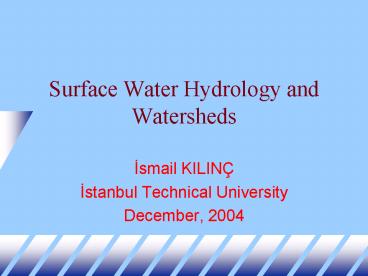Surface Water Hydrology and Watersheds
1 / 28
Title:
Surface Water Hydrology and Watersheds
Description:
The Hyetograph. Graph of Rainfall Rate vs Time at a Single Gage. Usually Plotted as a Bar Chart ... Hyetograph. Watershed. The Hydrograph. T. Q. Rainfall and ... –
Number of Views:1501
Avg rating:3.0/5.0
Title: Surface Water Hydrology and Watersheds
1
Surface Water Hydrology and Watersheds
- Ismail KILINÇ
- Istanbul Technical University
- December, 2004
2
The Hydrologic Cycle
3
Major Hydrologic Processes
- Precipitation (measured at rain gage)
- Evaporation or ET (loss to atmosphere)
- Infiltration (loss to subsurface)
- Overland Flow
- Stream Flow (measured at stage gage)
- Ground Water Flow
4
The Watershed or Basin
- Area of land that drains to a single outlet and
is separated from other watersheds by a drainage
divide. - Rainfall that falls in a watershed will create
runoff to that watershed outlet. - All other rainfall falling outside a basin will
not affect the runoff response.
5
Sample Watershed
6
(No Transcript)
7
The Hyetograph
- Graph of Rainfall Rate vs Time at a Single Gage
- Usually Plotted as a Bar Chart
- Net Rainfall is Found by Subtr. Infiltration
Losses - Integration of Net Rainfall in Time yields the
Total Rainfall Vol (DRO) in inches over a
Watershed
8
The Hydrograph
- Graph of Discharge vs Time at a Single Location
- Rising Limb, Crest Segment, Falling Limb,and
Recession - Base Flow is Usually Subtracted to yield DRO
- Peak Gives the Maximum Flow for the Event
9
- Hyetograph
- Watershed
- The Hydrograph
Q
T
10
Rainfall and Runoff Response
11
Unit Hydrograph Theory
- The unit hydrograph represents the basin response
to 1 cm of uniform net rainfall for a specified
duration. - Linear method originally devised in 1932.
- Works best for relatively small subareas.
- Several computational methods exist.
12
Methods of Unit Hydrograph
- From streamflow observations
- Synthetically
- Geomorphical methods
13
From streamflow data
- Measured at an
- observing station
- or elevation above
- a specific datum
- in a channel
(From Stream-Gaging Program of the U.S.
Geological Survey U.S. GEOLOGICAL SURVEY
CIRCULAR 1123 Reston, Virginia, 1995 By Kenneth
L. Wahl, Wilbert O. Thomas, Jr., and Robert M.
Hirsch )
14
From streamflow data
(From Stream-Gaging Program of the U.S.
Geological Survey U.S. GEOLOGICAL SURVEY
CIRCULAR 1123 Reston, Virginia, 1995 By Kenneth
L. Wahl, Wilbert O. Thomas, Jr., and Robert M.
Hirsch )
15
- Magnitude, shape and timing of hydrograph are
also dependent on - the characteristics of the watershed
- size ? slope
- shape ? storage
- the rainfall event
- intensity ? duration
16
Synthetic Unit Hydrograph Methods
- Snyders Method (1938)
- Clark TC R Method (1945)
- Nash (1958)
- SCS Method (1964)
17
(No Transcript)
18
(No Transcript)
19
(No Transcript)
20
(No Transcript)
21
(No Transcript)
22
(No Transcript)
23
(No Transcript)
24
Clark TC R Method
- The processes of translation and attenuation
dominate the movement of flow through a
watershed.
25
Clark UnitHydrograph Computation
26
Surface Runoff Theory
- TC Travel time of overland runoff from most
remote point to the outlet - R Routing Coefficient Relates Storage and
Outflow
where L channel length (mi) S slope of
channel (ft/mi) LCA length to centroid (mi) D
0.94 for developed watersheds of Solt20
ft/mi So watershed slope (ft/mi)
27
(No Transcript)
28
- Thank you






























